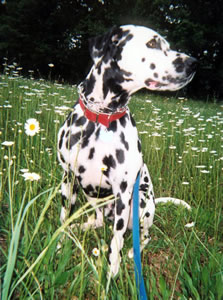Dalmatian
Dog Breed Info: All Dog Breeds

Dalmatian
Coach Dog, Firehouse Dog
- Distinctive white coat and black spots
- Devoted family friend whose energetic and outgoing
- Athletic companion dog that loves to run
| Group | Non-Sporting Group |
| Breed Description | The Dalmatian is a strong, active, muscular, well-balanced dog and is unmistakably familiar with it’s white coat and either black or liver spots. It has a smooth, square head and a long muzzle. It’s eyes are round, bright and fairly wide-set. The Dalmatian’s ears are tapered, with rounded tips and are carried close to the head. It’s energetic and outgoing as can be indicated with the wagging of its strong, upward curved tail. The Dalmatian has a deep chest with a sleek and muscular build and a long broad, perfectly straight back. |
| Temperament | The Dalmatian is a very spirited, confident dog which is friendly and easy to train. Male Dalmatians tend to show aggression towards other male dogs. Dalmatians are very affectionate and patient with children if they are raised with them. The Dalmatian demonstrates great patience, kindness, and is proven to be a very obedient, courageous guard dog. |
| Height/Weight | Height: Dogs 22-24 inches (50-60 cm), Bitches 20-22 inches (50-55 cm) Weight: Dogs 50-55 pounds (22-25 kg), Bitches 48-52 pounds (21-23 kg) |
| Health Issues | Dalmatians are usually a healthy breed, but about 10% of Dalmatians are born totally deaf, and another 20% of Dalmatian dogs can only hear in one ear. It is important to get Dalmatians tested early on using a testing method called ‘Brainstem Auditory Evoked Response’ (BAER). Dalmatians are also known to develop bladder stones – but this can be prevented through proper diet. Dalmatians also experience allergies and eczema (skin) problems. |
| Life Expectancy | 10 to 14 years. |
| Exercise | Dalmatians need plenty of exercise and they love to run. Dalmatians were bread to run along side horses, so they inherently have the need to run. Long walks and a ton of playtime is needed to keep the Dalmatian fit. Playing fetch in a big yard is a good way to keep them moving. |
| Living Conditions | Dalmatians are best with a bigger yard and don’t do so well in apartments due to there large size and need to run (exercise) daily. This breed of dog is sensitive to the cold. |
| Grooming | Dalmatians keep themselves relatively clean in the same manner a cat would. Frequent brushing helps to keep them clean and helps maintain their short, dense glossy coat. Shedding can be minimized by daily brushing. |
| Breed Origin | There is a lot of controversy over where the Dalmatian originated. Many people believe Dalmatian’s originated in Dalmatia (a region of Yugoslavia). Some people believe that the Dalmatian comes from breeding (the now extinct) Bengali Braque with the Bull Terrier and the Pointer. In the 1800’s the Dalmatian was used to accompany horse drawn carriages. The Dalmatian’s size allowed them to fit under the rear axle of the coach, where they often ran and their stamina allowed them to keep up with the horses. Dalmatian’s were used to guard their owners coach and belongings. The Dalmatian is most famous for being the fire house dog. |